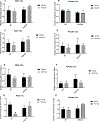PCB126 induced toxic actions on liver energy metabolism is mediated by AhR in rats
- PMID: 34848246
- PMCID: PMC8748418
- DOI: 10.1016/j.tox.2021.153054
PCB126 induced toxic actions on liver energy metabolism is mediated by AhR in rats
Abstract
The aryl hydrocarbon receptor (AhR) is a ligand-activated transcription factor involved in the regulation of biological responses to more planar aromatic hydrocarbons, like TCDD. We previously described the sequence of events following exposure of male rats to a dioxin-like polychlorinated biphenyl (PCB) congener, 3,3',4,4',5-pentachlorobiphenyl (PCB126), that binds avidly to the AhR and causes various types of toxicity including metabolic syndrome, fatty liver, and disruption of energy homeostasis. The purpose of this study was, to investigate the role of AhR to mediate those toxic manifestations following sub-acute exposure to PCB126 and to examine possible sex differences in effects. For this goal, we created an AhR knockout (AhR-KO) model using CRISPR/Cas9. Comparison was made to the wild type (WT) male and female Holtzman Sprague Dawley rats. Rats were injected with a single IP dose of corn oil vehicle or 5 μmol/kg PCB126 in corn oil and necropsied after 28 days. PCB126 caused significant weight loss, reduced relative thymus weights, and increased relative liver weights in WT male and female rats, but not in AhR-KO rats. Similarly, significant pathologic changes were visible which included necrosis and regeneration in female rats, micro- and macro-vesicular hepatocellular vacuolation in males, and a paucity of glycogen in livers of both sexes in WT rats only. Hypoglycemia and lower IGF1, and reduced serum non-esterified fatty acids (NEFAs) were found in serum of both sexes of WT rats, low serum cholesterol levels only in the females, and no changes in AhR-KO rats. The expression of genes encoding enzymes related to xenobiotic metabolism (e.g. CYP1A1), gluconeogenesis, glycogenolysis, and fatty acid oxidation were unaffected in the AhR-KO rats following PCB126 exposure as opposed to WT rats where expression was significantly upregulated (PPARα, females only) or downregulated suggesting a disrupted energy homeostasis. Interestingly, Acox2, Hmgcs, G6Pase and Pc were affected in both sexes, the gluconeogenesis and glucose transporter genes Pck1, Glut2, Sds, and Crem only in male WT-PCB rats. These results show the essential role of the AhR in glycogenolysis, gluconeogenesis, and fatty acid oxidation, i.e. in the regulation of energy production and homeostasis, but also demonstrate a significant difference in the effects of PCB126 in males verses females, suggesting higher vulnerability of glucose homeostasis in males and more changes in fatty acid/lipid homeostasis in females. These differences in effects, which may apply to more/all AhR agonists, should be further analyzed to identify health risks to specific groups of highly exposed human populations.
Keywords: AhR Knockout rats; Energy homeostasis; Fatty acid oxidation; Gene expression; Glucose homeostasis; Liver toxicity; PCB126; Sex differences.
Copyright © 2021 Elsevier B.V. All rights reserved.
Conflict of interest statement
Competing interest
There is no conflict of interest to disclose.
Figures










Similar articles
-
Metabolic Side Effects from Antipsychotic Treatment with Clozapine Linked to Aryl Hydrocarbon Receptor (AhR) Activation.Biomedicines. 2024 Oct 10;12(10):2294. doi: 10.3390/biomedicines12102294. Biomedicines. 2024. PMID: 39457607 Free PMC article. Review.
-
PCB126-Induced Disruption in Gluconeogenesis and Fatty Acid Oxidation Precedes Fatty Liver in Male Rats.Toxicol Sci. 2016 Jan;149(1):98-110. doi: 10.1093/toxsci/kfv215. Epub 2015 Sep 22. Toxicol Sci. 2016. PMID: 26396156 Free PMC article.
-
The Aryl hydrocarbon receptor mediates reproductive toxicity of polychlorinated biphenyl congener 126 in rats.Toxicol Appl Pharmacol. 2021 Sep 1;426:115639. doi: 10.1016/j.taap.2021.115639. Epub 2021 Jul 10. Toxicol Appl Pharmacol. 2021. PMID: 34256052 Free PMC article.
-
PCB126 Inhibits the Activation of AMPK-CREB Signal Transduction Required for Energy Sensing in Liver.Toxicol Sci. 2018 Jun 1;163(2):440-453. doi: 10.1093/toxsci/kfy041. Toxicol Sci. 2018. PMID: 29474705 Free PMC article.
-
NTP toxicology and carcinogenesis studies of 3,3',4,4',5-pentachlorobiphenyl (PCB 126) (CAS No. 57465-28-8) in female Harlan Sprague-Dawley rats (Gavage Studies).Natl Toxicol Program Tech Rep Ser. 2006 Jan;(520):4-246. Natl Toxicol Program Tech Rep Ser. 2006. PMID: 16628245
Cited by
-
Transcriptome sequencing of 3,3',4,4',5-Pentachlorobiphenyl (PCB126)-treated human preadipocytes demonstrates progressive changes in pathways associated with inflammation and diabetes.Toxicol In Vitro. 2022 Sep;83:105396. doi: 10.1016/j.tiv.2022.105396. Epub 2022 May 23. Toxicol In Vitro. 2022. PMID: 35618242 Free PMC article.
-
Metabolic Side Effects from Antipsychotic Treatment with Clozapine Linked to Aryl Hydrocarbon Receptor (AhR) Activation.Biomedicines. 2024 Oct 10;12(10):2294. doi: 10.3390/biomedicines12102294. Biomedicines. 2024. PMID: 39457607 Free PMC article. Review.
-
From Nucleus to Organs: Insights of Aryl Hydrocarbon Receptor Molecular Mechanisms.Int J Mol Sci. 2022 Nov 29;23(23):14919. doi: 10.3390/ijms232314919. Int J Mol Sci. 2022. PMID: 36499247 Free PMC article. Review.
-
Early Life Polychlorinated Biphenyl 126 Exposure Disrupts Gut Microbiota and Metabolic Homeostasis in Mice Fed with High-Fat Diet in Adulthood.Metabolites. 2022 Sep 23;12(10):894. doi: 10.3390/metabo12100894. Metabolites. 2022. PMID: 36295797 Free PMC article.
-
Complex roles for sulfation in the toxicities of polychlorinated biphenyls.Crit Rev Toxicol. 2024 Feb;54(2):92-122. doi: 10.1080/10408444.2024.2311270. Epub 2024 Feb 16. Crit Rev Toxicol. 2024. PMID: 38363552 Free PMC article. Review.
References
-
- Auer RN 2004. Hypoglycemic brain damage. Forensic science international 146, 105–110. - PubMed
-
- Baba T, Mimura J, Gradin K, Kuroiwa A, Watanabe T, Matsuda Y, Inazawa J, Sogawa K and Fujii-Kuriyama Y 2001. Structure and expression of the Ah receptor repressor gene. Journal of Biological Chemistry 276, 33101–33110. - PubMed
-
- Bae J, Peters-Golden M and Loch-Caruso R 1999. Stimulation of pregnant rat uterine contraction by the polychlorinated biphenyl (PCB) mixture Aroclor 1242 may be mediated by arachidonic acid release through activation of phospholipase A2 enzymes. Journal of Pharmacology and Experimental Therapeutics 289, 1112–1120. - PubMed
Publication types
MeSH terms
Substances
Grants and funding
LinkOut - more resources
Full Text Sources
Research Materials
Miscellaneous

